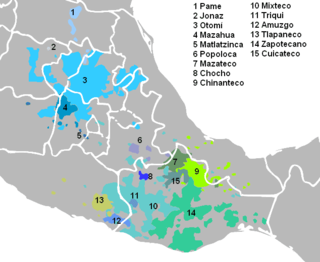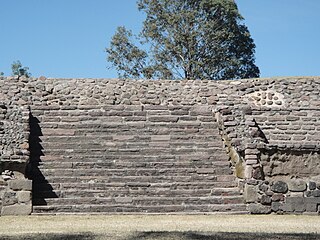See also
- Chichimeca, a historic group of peoples
| This disambiguation page lists articles associated with the title Chichimeca Jonaz. If an internal link led you here, you may wish to change the link to point directly to the intended article. |
Chichimeca Jonaz may refer to:
| This disambiguation page lists articles associated with the title Chichimeca Jonaz. If an internal link led you here, you may wish to change the link to point directly to the intended article. |

Guanajuato, officially the Free and Sovereign State of Guanajuato, is one of the 32 states which make up the Federal Entities of Mexico. It is divided into 46 municipalities and its capital city is Guanajuato. The largest city in the state is León.

Chichimeca was the name that the Nahua peoples of Mexico generically applied to nomadic and semi-nomadic peoples who were established in present-day Bajio region of Mexico. Chichimeca carried the same sense as the Roman term "barbarian" to describe Germanic tribes. The name, with its pejorative sense, was adopted by the Spanish Empire. For the Spanish, in the words of scholar Charlotte M. Gradie, "the Chichimecas were a wild, nomadic people who lived north of the Valley of Mexico. They had no fixed dwelling places, lived by hunting, wore little clothes and fiercely resisted foreign intrusion into their territory, which happened to contain silver mines the Spanish wished to exploit." In spite of not having temples or idols, they practiced animal and human sacrifice, and they were feared for their expertise and brutality in war.

Oto-Manguean or Otomanguean languages are a large family comprising several subfamilies of indigenous languages of the Americas. All of the Oto-Manguean languages that are now spoken are indigenous to Mexico, but the Manguean branch of the family, which is now extinct, was spoken as far south as Nicaragua and Costa Rica. Oto-Manguean is widely viewed as a proven language family. However, this status has been recently challenged.

The Otomi are an indigenous people of Mexico inhabiting the central Mexican Plateau (Altiplano) region.

The Zacatecos is the name of an indigenous group, one of the peoples called Chichimecas by the Aztecs. They lived in most of what is now the state of Zacatecas and the northeastern part of Durango. They have many direct descendants, but most of their culture and traditions have disappeared with time. Large concentrations of modern-day descendants may reside in Zacatecas and Durango, as well as other large cities of Mexico.
The Chichimeca War (1550–90) was a military conflict between the Spanish Empire and the Chichimeca Confederation established in the territories today known as the Central Mexican Plateau, called by the Conquistadores La Gran Chichimeca. The epicenter of the hostilities was the region now called the Bajío. The Chichimeca War is recorded as the longest and most expensive military campaign confronting the Spanish Empire and indigenous people in Mesoamerica. The forty-year conflict was settled through several peace treaties driven by the Spaniards which led to the pacification and, ultimately, the streamlined integration of the native populations into the New Spain colonial order.

The Tepanecs or Tepaneca are a Mesoamerican people who arrived in the Valley of Mexico in the late 12th or early 13th centuries. The Tepanec were a sister culture of the Aztecs as well as the Acolhua and others—these tribes spoke the Nahuatl language and shared the same general pantheon, with local and tribal variations.
Colón is a town in Colón Municipality of the State of Querétaro, Mexico. It is the only one in the country named after Christopher Columbus. It's the state's third largest municipality, with 815 square kilometers. Its mean altitude is 1900 meters above sea level. The Continental Divide of the Americas runs through it.

Peñamiller is a town in Peñamiller Municipality in the Mexican state of Querétaro. It is part of the Sierra Gorda region with about eighty percent of the territory belonging to the Sierra Gorda Biosphere of Querétaro. The municipality is on the southwest side of the Sierra Gorda, the highest mountains of which block most of the moisture coming in from the Gulf of Mexico. For this reason, most of the territory is arid, part of what is called the Querétaro “semi-desert” filled with cactus. There is a small portion on the far east side which has temperate forests and bodies of water, mostly related to the Extoraz River, in which fish are raised. The name of the town and municipality comes from a mountain called “El Picacho” but reminded town founder José de Escandón of the Peña Mellera in Spain. Over time, the name morphed into Peñamiller.

The north Pame, or Xi'iuy, as they refer to themselves, the south Pame, or Ñáhu, Nyaxu, and the Pame in Querétaro or Re Nuye Eyyä, are an Indigenous people of central Mexico primarily living in the state of San Luis Potosí. When Spanish colonizers arrived and conquered their traditional territory in the sixteenth century, which "extended from the modern state of Tamaulipas in the north to Hidalgo and the area around Mexico City in the south along the Sierra Madre," they renamed "the area Pamería, and applied the name Pame to all of the peoples there."
Matlatzinca is a name used to refer to different indigenous ethnic groups in the Toluca Valley in the state of México, located in the central highlands of Mexico. The term is applied to the ethnic group inhabiting the valley of Toluca and to their language, Matlatzinca.

The Chichimeca Jonaz are an indigenous people of Mexico, living in the states of Guanajuato and San Luis Potosí. In Guanajuato, the Chichimeca Jonaz people live in a community in San Luis de la Paz municipality. The settlement is 2,070 m above sea level. They call this place Rancho Úza or Misión Chichimeca. They are descendants of the Pame people, who fought in the Chichimeca War (1550-1590) in the Chichimeca Confederation.

The Pame languages are a group of languages in Mexico that is spoken by around 10,000 Pame people in the state of San Luis Potosí. It belongs to the Oto-Pamean branch of the Oto-Manguean language family.
Chichimeca or Chichimeca Jonaz is an indigenous language of Mexico spoken by around 200 Chichimeca Jonaz people in Misión de Chichimecas near San Luis de la Paz in the state of Guanajuato, Mexico. The Chichimeca Jonaz language belongs to the Oto-Pamean branch of the Oto-Manguean language family. The Chichimecos self identify as úza and call their language eza'r.

Peralta is a prehispanic mesoamerican archaeological site located in Abasolo Municipality, Guanajuato, just outside the village of San Jose de Peralta in the Mexican state of Guanajuato. The site is reached via Fed 90 from Irapuato. Approximately 15.5 km south of the intersection with Fed 45, take the Irapuato-Huanimaro route southeast (left). Follow the route for about 12.5 km, then turnoff southwest (right) to San Jose de Peralta. Cross the bridge and turn right, and then follow the road out of the village northwest about 1 km. The site is on the left.

Plazuelas is a prehispanic archaeological site located just north of San Juan el Alto, some 2.7 kilometers (1.57 mi.) north of federal highway 90 (Pénjamo-Guadalajara), and about 11 kilometers (6.8 mi.) west of the city of Pénjamo in the state of Guanajuato, Mexico. The site is open to the public; it is dominated by a large, rectangular plaza with several pyramidal structures and platforms, along with a massive ball court. To the north of the structures is a field of boulders with thousands of glyphs carved into them.

El Conde is an archeological site located at Ozumba Street, El Conde, three block north the Mayo 1 Ave., in the municipality of Naucalpan, Mexico State.
El Teúl is an important archaeological mesoamerican site located on a hill with the same name in the Teúl Municipality in the south of the Zacatecas State, Mexico, near the Jalisco State.
The Ximpece are an Indigenous people of Mexico who were a semi-nomadic ethnic group of Chichimecas who lived among the Pame and the Jonaz. The National Commission for the Development of Indigenous Peoples reported that "about 60,000 Amerindians live in the state of Querétaro, belonging to the Otomi, Chichimeca, Pame, Jonace and Ximpece peoples." It is unclear whether the Ximpece exist today as an intact cultural group due to minimal historical and contemporary sources.
Chichimeco may refer to: